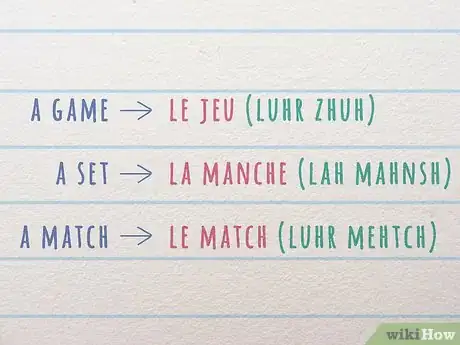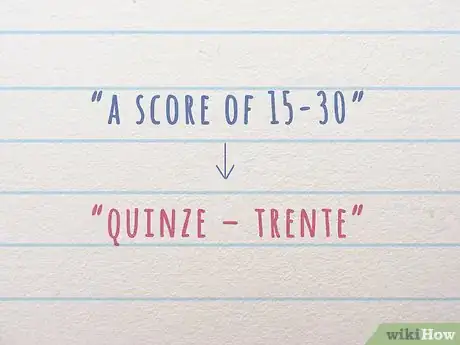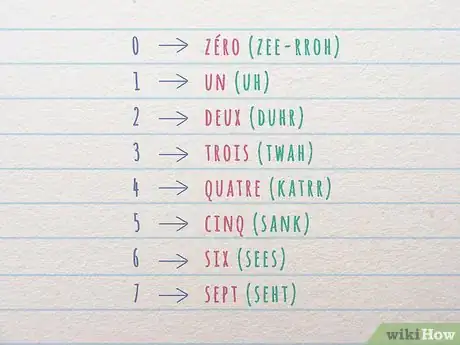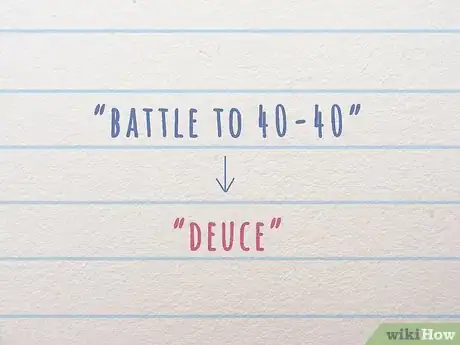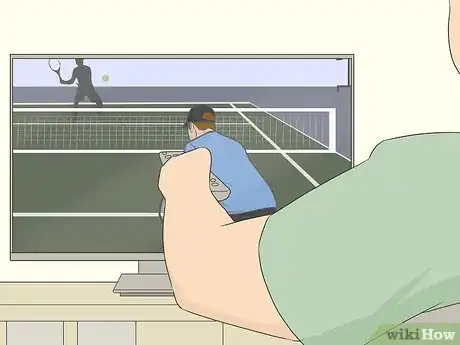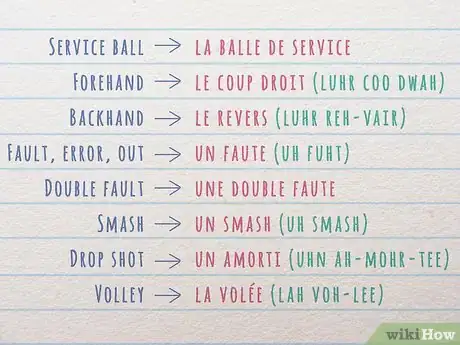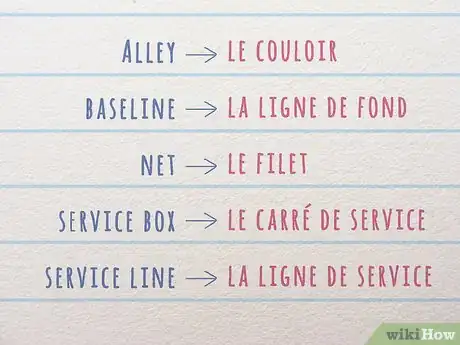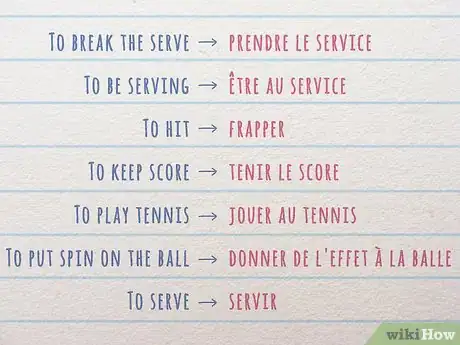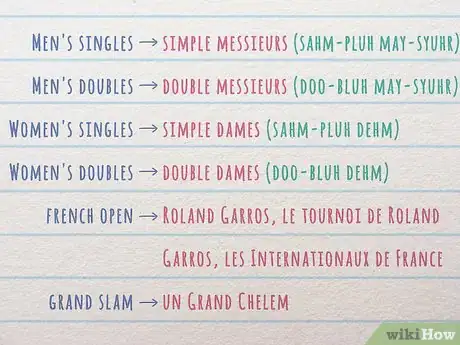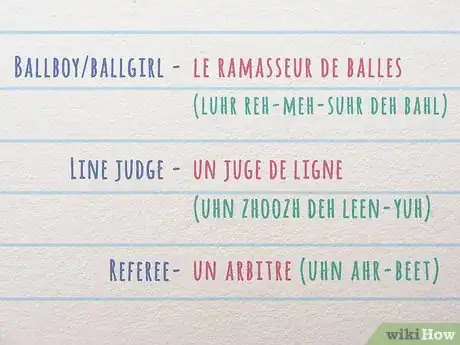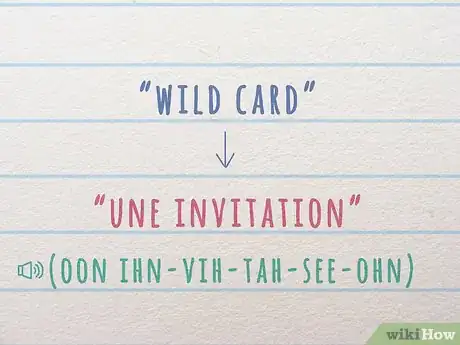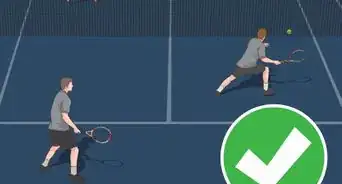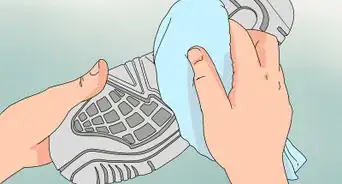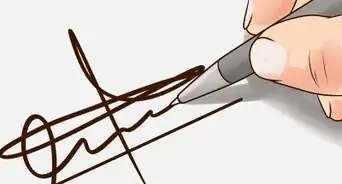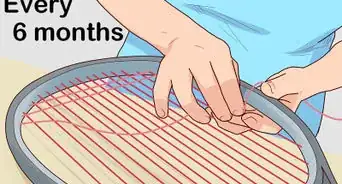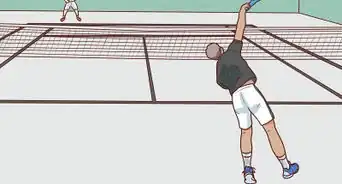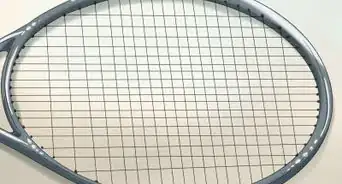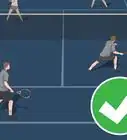This article was co-authored by wikiHow staff writer, Jennifer Mueller, JD. Jennifer Mueller is a wikiHow Content Creator. She specializes in reviewing, fact-checking, and evaluating wikiHow's content to ensure thoroughness and accuracy. Jennifer holds a JD from Indiana University Maurer School of Law in 2006.
wikiHow marks an article as reader-approved once it receives enough positive feedback. In this case, several readers have written to tell us that this article was helpful to them, earning it our reader-approved status.
This article has been viewed 97,270 times.
Learn more...
In any language, sports vocabulary is often separate from the words you might use to carry on a daily conversation. Whether you're a player or an avid fan, learning how to talk about your favorite sport in another language increases your fluency and understanding of that language. Tennis is a sport that evolved from a French game, but many of French tennis terms differ from the English equivalent.[1] While you keep score in tennis in French the same way you do in any other language, you would use French numbers. Beyond that, there are other French words you might want to know if you're watching Roland Garros (known to English-speakers as the French Open).[2]
Steps
Calling the Score
-
1Divide the entire match into games and sets. A tennis match consists of either 3 or 5 sets. A tennis player must win 6 games in each set to win the set and at least 2 sets more than the other player to win the match. Each of these match divisions has French words you probably want to become familiar with, although the words themselves aren't typically used when calling the score.[3]
- A game is le jeu (luhr zhuh).
- A set is la manche (lah mahnsh).
- A match is le match (luhr mehtch). Note that this doesn't follow the traditional rules of French pronunciation because the word "match" is borrowed from English in this context.
-
2Use French number words for points scored in each game. The system of scoring a tennis match is unique among sports. The first point in a game is 15, the second is 30, the third is 40, and the fourth (if there is one) is the game point. A player must score at least 2 points more than the other player to win a game. If the game is tied, most tennis games progress through deuce (a tied score of 40-40), advantage, and then game point. To keep score in French, use the following words:[4]
- Pas de point (no points): 0 zéro (zee-rroh)
- Premier point (first point): 15 quinze (kanz)
- Second point (second point): 30 trente (trahn)
- Troisième point (third point): 40 quarante (kah-rrohn)
- Quatrième point (fourth point): Jeu (zhuh)
Where's the Love? In English, the word "love" indicates a player has not yet scored a point. Allegedly, this term arose from the French word l'oeuf, meaning "egg," similar to how some English speakers say "goose egg" to mean "zero." However, French speakers don't say either l'oeuf or l'amour (love) in this context. They simply say "zéro."
Advertisement -
3Say the game score before each serve following a point. Unless you're playing in a professional or competitive context with an official scorekeeper, it's the server's job to repeat the score before they serve the ball. The server's score comes first, followed by the receiver's score. If the score is tied, use partout (pahrtooh) or A (ah) after the server's score. This is the same as saying "15 all" or "30 all" in English.[5]
- For example, for a score of 15-30, you would say "quinze – trente."
-
4Repeat the set score before each new game begins. At the start of a new game, there isn't a game score for the server to call out. Instead of saying "zéro – zéro," at the start of the new game the server (or scorekeeper, at professional or competitive matches) calls out the score in the set so far. For this, you'll need to know how to count to at least 7 in French. Use the following French number words, depending on the number of games each player has won in the set so far:[6]
- 0: zéro (zee-rroh)
- 1: un (uh)
- 2: deux (duhr)
- 3: trois (twah)
- 4: quatre (katrr)
- 5: cinq (sank)
- 6: six (sees)
- 7: sept (seht)
Tip: As with the score of each game, the server announces their score first, followed by the score of the receiver. If a scorekeeper is used, they would also announce the server's score first, followed by the receiver's score.
-
5Play each game until someone wins by two points. In tennis, you must win by two points to get credit for winning the game. If the players battle to 40-40, this is referred to as "deuce," or égalité (ay-gah-lee-tay) in French.[7]
- If the server scores a point after égalité, the score would be avantage service (ah-vahn-tazh sehr-vees). If the server scored again, that would end the game. On the other hand, if the receiver scores, you are back to égalité.
- If the receiver scores a point after égalité, the score would be avantage dehors (ah-vahn-tazh duh-ohr). After égalité, you don't use any numbers to call the score, just whichever of these three phrases is appropriate.
-
6Keep score until the match is over. You really only need to know a few number words and a handful of other words to keep score in Tennis in French, provided you have a little understanding already regarding how the game is scored.[8]
- Once one of the players wins a set, the game score is absorbed into the point for that set, so those numbers don't have to be repeated again. At the end of each set, the set score also starts over. You don't have to repeat the score for the previous set.
- If you're keeping score on paper, you would simply enter the points for each set on the score sheet.
Tip: As in English, there's no need to add a word between the two scores. Simply say the numbers one after the other, with the server's score first, followed by the receiver's score.
Talking about a Match
-
1Use French terms for serves and shots. When you're talking about a tennis match in French, you need to know the correct words for the types of serves and shots that you'll witness over the course of the match. These words are particularly likely to come up when discussing the score of the match. Many words that describe shots are the same as the words you would use in English. French terms to know include:[9]
- Serve, service: le service (luhr sehr-vees)
- Service ball: la balle de service (lah bahl deh sehr-vees)
- Ace: un ace (uhn ays)
- Forehand: le coup droit (luhr coo dwah)
- Backhand: le revers (luhr reh-vair)
- Two-handed backhand: le revers à deux mains (luhr reh-vair ah duhr mahn)
- Fault, error, out: un faute (uh fuht)
- Double fault: une double faute (oon doo-bluh fuht)
- Let: un let (uh leht)
- Lob: un lob (uh lahb)
- Slice: le slice (luhr slice)
- Smash: un smash (uh smash)
- Drop shot: un amorti (uhn ah-mohr-tee)
- Volley: la volée (lah voh-lee)
Tip: A tennis racket is referred to as la raquette (lah rah-ket) in French. The tennis ball is la balle de tennis (lah bahl de tehn-ees) or simply la balle.
-
2Describe the court where the match is being played. In tennis, you may play on a clay court, grass court, or hard court. If you're talking about tennis in French, it can be helpful to know the French words for the different types of courts, as well as the court itself.[10]
- The English word "court" is, itself, derived from the French word court (kohrr). You'll also hear a tennis court referred to in French as le terrain (luhr teh-rrahng).
- A clay court is le court de terre battue (luhr kohrr deh tair bah-choo)
- A hard court is le court en dur (luhr kohrr ahn duhrr)
- A grass court is le court en gazon (luhrn kohrr ahn geh-zohn).
Tip: If you watch professional tennis, you may recognize that the Wimbledon tournament is played on a grass court, the U.S. Open on a hard court, and the French Open (Roland Garros to the French) on a clay court.
-
3Identify the different parts of the court. Learning French words for the lines, net, and different areas of the court can help if you're describing where a shot landed. French words you can learn to help you identify different parts of the court include:[11]
- Alley: le couloir (luh coo-loo-wah)
- Baseline: la ligne de fond (lah leen deh fohn)
- Net: le filet (luh fee-lay)
- Service box: le carré de service (luh keh-rray deh sehr-vees
- Service line: la ligne de service (lah leen deh sehr-vees)
-
4Try tennis-related French verbs to explain actions in the match. If you already know how to speak French a little and feel relatively confident in your ability to conjugate French verbs, you can also talk about what's going on in the match in French. Infinitives and verb phrases you might use include:[12]
- To break the serve: prendre le service
- To be serving: être au service
- To hit: frapper
- To keep score: tenir le score
- To play tennis: jouer au tennis
- To put spin on the ball: donner de l'effet à la balle
- To serve: servir
Using Other French Tennis Terms
-
1Identify matches and tournaments using French terms. If you're talking about a particular tennis match, you may also want to use the French terminology to describe the type of match it is or the tournament during which the match was played. Some names for matches and tournaments you might want to use are:[13]
- Men's singles: simple messieurs (sahm-pluh may-syuhr)
- Men's doubles: double messieurs (doo-bluh may-syuhr)
- Women's singles: simple dames (sahm-pluh dehm)
- Women's doubles: double dames (doo-bluh dehm)
- French Open: Roland Garros, le tournoi de Roland Garros, Les Internationaux de France
- Grand Slam: un Grand Chelem
-
2Learn names for officials and other court personnel. In a casual game of tennis, the players are the only people on the court. However, in competitive matches and tournament play, you'll have various officials and court personnel that you'll have to identify. The French names for some of these positions are:[14]
- Ballboy/ballgirl: le ramasseur de balles (luhr reh-meh-suhr deh bahl). Unlike in English, the French term le ramasseur de balles simply means "the gatherer of balls," and is gender-neutral.
- Line judge: un juge de ligne (uhn zhoozh deh leen-yuh)
- Referee: un arbitre (uhn ahr-beet)
Tip: A call made by either un arbitre or un juge de ligne is referred to in French as une décision (oohn day-see-zhee-ong).
-
3Talk about a player's tournament rank in the tournament in French. When professional tennis players enter a tournament, they are ranked according to their performance in past tournaments. These rankings, or "seeds," in part, determine which players play each other and ensure the best players end up making it to the final rounds.[15]
- When talking about the player's tournament seed, use the phrase la tête de série (lah teh duh sehr-ee). If the player is the top seed or number-one seed, you would say they were la tête de série numéro un. A number-two seed player would be la tête de série numéro deux, and so on.
- If a player enters the tournament on a "wild card," use the term une invitation (oon ihn-vih-tah-see-ohn).
Community Q&A
-
QuestionWhat is "tie break" in French?
 Community Answer"Jeu décisif" is French for tie break.
Community Answer"Jeu décisif" is French for tie break. -
QuestionHow do I say "one game all" in French?
 Community AnswerYou can say, "un jeu tous."
Community AnswerYou can say, "un jeu tous." -
QuestionWhat is thirty love?
 Community Answer'Love' is the term for '0' in tennis. People are unsure of its origin but it just means 0. The points system is as follows: Love(0), 15, 30, 40. So 15 = 1 rally won, 30 = 2 rallys won and 40 = 3 rallys won. (Whoever serves their score is called first. So Thirty love means the server has won 2 rallys (30) and the receiver is on 0 (Love).
Community Answer'Love' is the term for '0' in tennis. People are unsure of its origin but it just means 0. The points system is as follows: Love(0), 15, 30, 40. So 15 = 1 rally won, 30 = 2 rallys won and 40 = 3 rallys won. (Whoever serves their score is called first. So Thirty love means the server has won 2 rallys (30) and the receiver is on 0 (Love).
Warnings
- The pronunciation guides in parentheses after French words are only approximations. Where you see an "ng," this signals that the preceding vowel is a nasal vowel. To pronounce the words correctly, listen to a native speaker saying them and practice over and over.⧼thumbs_response⧽
References
- ↑ https://tennismash.com/2016/02/23/the-origins-of-the-most-common-words-in-tennis/
- ↑ https://nationalpost.com/pmn/sports-pmn/whats-in-a-name-you-say-french-open-i-say-roland-garros
- ↑ https://www.fft.fr/file/7966/download?token=DmjkAHAr
- ↑ https://www.fft.fr/file/7966/download?token=DmjkAHAr
- ↑ https://www.fft.fr/file/7966/download?token=DmjkAHAr
- ↑ https://www.fft.fr/file/7966/download?token=DmjkAHAr
- ↑ https://www.lawlessfrench.com/vocabulary/tennis/
- ↑ https://www.lawlessfrench.com/vocabulary/tennis/
- ↑ https://www.lawlessfrench.com/vocabulary/tennis/
- ↑ https://www.lawlessfrench.com/vocabulary/tennis/
- ↑ https://www.lawlessfrench.com/vocabulary/tennis/
- ↑ https://www.lawlessfrench.com/vocabulary/tennis/
- ↑ https://www.lawlessfrench.com/vocabulary/tennis/
- ↑ https://www.lawlessfrench.com/vocabulary/tennis/
- ↑ https://www.lawlessfrench.com/vocabulary/tennis/
